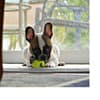Podcast
Questions and Answers
To get depth, the photographer will use a ______ lens with a large 'f' number.
To get depth, the photographer will use a ______ lens with a large 'f' number.
small
Increasing depth can be accomplished by moving further away from the subject of the photograph, but this often distorts the photograph by changing the size of the subject's ______.
Increasing depth can be accomplished by moving further away from the subject of the photograph, but this often distorts the photograph by changing the size of the subject's ______.
image
A more plausible way to change depth is to set the ______ (lens opening) to a higher number.
A more plausible way to change depth is to set the ______ (lens opening) to a higher number.
aperture
When photographing a moving subject, a fast ______ speed will be needed to stop the action.
When photographing a moving subject, a fast ______ speed will be needed to stop the action.
Moving away from the subject of the photograph will give a greater ______.
Moving away from the subject of the photograph will give a greater ______.
Telephoto lenses will have considerably less ______ than normal lenses.
Telephoto lenses will have considerably less ______ than normal lenses.
The term 'depth' is really used to describe the ______ that the investigator can move away from the subject and still maintain a sharp image.
The term 'depth' is really used to describe the ______ that the investigator can move away from the subject and still maintain a sharp image.
Depth is the area in front and at the back of the ______.
Depth is the area in front and at the back of the ______.
When depth is an important element of the photograph, use the ______ aperture possible to keep the picture sharp.
When depth is an important element of the photograph, use the ______ aperture possible to keep the picture sharp.
The shutter speed, however, must also be adjusted because of the corresponding light restriction that will naturally occur when going to a higher 'f' ______.
The shutter speed, however, must also be adjusted because of the corresponding light restriction that will naturally occur when going to a higher 'f' ______.
Flashcards are hidden until you start studying
Study Notes
Police Photography
- In police photography, adjustments must be made to both the camera and flash unit to obtain a properly exposed photograph.
Flash Unit Settings
- The flash unit must be adjusted to the proper ASA/ISO setting according to the speed of the film being used.
- The Vivitar 283 flash unit has four automatic settings and a manual mode, indicated by color codes (yellow, red, blue, mauve) on the flash scale dial.
- The color codes indicate the maximum distance capability and required "T" stop (lens aperture setting).
- The Thyristor Sensor on the front of the flash must be adjusted to correspond to the color code on the flash scale.
Depth of Field (DOF)
- When choosing a setting, consider both the distance requirement and the desired depth of field (DOF).
- Color code yellow (f/2.8) has little DOF, while color code mauve (f/11) gives the greatest DOF.
- A compromise must be reached between distance and DOF.
Focus
- Focus is defined as the physical point at which rays of light from a lens converge to form a properly defined image of the subject.
- Sharpness or focus of a photograph can make a difference in a court of law.
Available Light Photography
- Set the ASA or ISO dial according to the film speed when inserting a roll of film in the camera.
- Use a shutter speed of 1/125 sec as a starting point for crime or accident scenes.
- Adjust the light meter needle by turning the aperture ring until properly lined up.
- Use a shutter speed faster than 1/30 of a second for handheld photographs.
- Use a tripod for shutter speeds of 1/30 of a second or slower.
Exposure Using Flash (Artificial Light)
- The flash is an important tool for police photography, providing front lighting and allowing for more control than available light.
- Steps to follow for proper exposure using flash:
- Adjust the flash unit to the proper ASA/ISO setting.
- Choose the appropriate color code setting based on distance and DOF requirements.
- Adjust the Thyristor Sensor to correspond to the color code on the flash scale.
Controlling Depth
- Use a small lens with a large "f" number to get depth in a photograph.
- Increasing depth can be accomplished by:
- Moving further away from the subject (but this can distort the image).
- Setting the aperture to a higher number (but this requires adjusting the shutter speed).
- Use the smallest aperture possible to keep the picture sharp when depth is an important element.
- Fast shutter speeds are needed when photographing moving subjects.
Studying That Suits You
Use AI to generate personalized quizzes and flashcards to suit your learning preferences.





